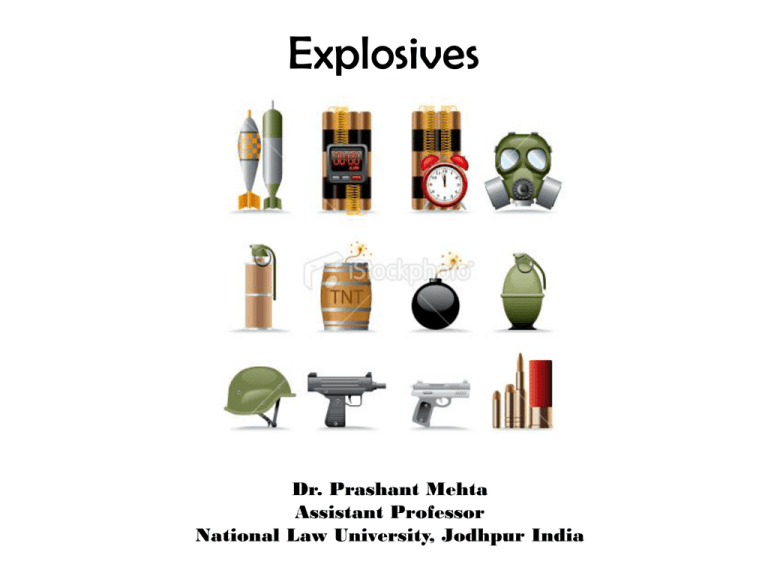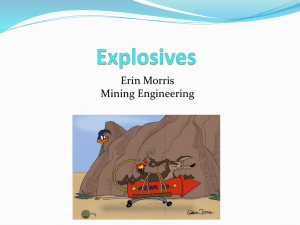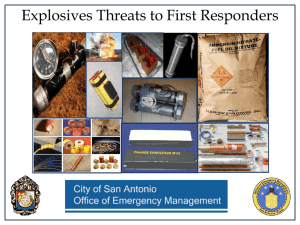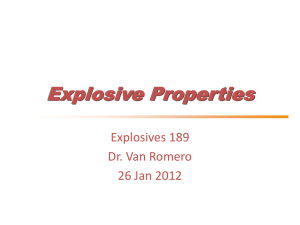explosives-110221233815
advertisement

Explosives Dr. Prashant Mehta Assistant Professor National Law University, Jodhpur India Explosives An explosive is a substance or a mixture, which when subjected to thermal or mechanical shock, gets very rapidly oxidized exothermically into products of greatly increased volume with sudden release of potential energy. In explosive reactions the products get heated up to very high temperature and exert very high temperature on surroundings which can be used for constructive or destructive purposes. When an explosion occurs in a confined space, the high pressure conditions developed within the system can be instrumental to shatter the confining walls. The quantity of power realizable from given weight(or volume) of an explosive is called “power to weight(or volume) ratio”-which is quite small in the case of gases but large in solids or liquids when used as explosives. Explosives are mainly used for defense purposes, for blasting mines for obtaining ores, drilling holes in mountains for constructing tunnels, quarrying purposes, excavating earth(for dams), seismic prospecting etc. Explosives Terminology Velocity of Detonation (VOL) – is the velocity with which the given explosive detonates. It value also depends upon the density of powdered explosives. Explosive Strength – is the energy liberated per unit mass of the explosive (cal/gm). Blasting gelatin is the strongest commercial dynamite). Brisance – refers to the shattering power of the explosives. Sensitivity – of an explosive to impact, friction or heat or electric spark or detonator wave. Sensitivity plays a key role in the selection of explosive for a particular purpose. Classification of Explosive Explosives may be in the form of solids TNT(trinitrotoluene), liquids or gases (H2 and O2). They may exist as a single component (TNT), a mixture of two or more substances none of which is an explosives by itself (gun powder), a mixture of one or more explosives compounds (TNT + NH4NO3) or an explosives compound mixed with a nonexplosive material (dynamite). A variety of inorganic or organic compounds can serve as explosives. They are generally in the form of nitrates, chlorates, perchlorates, peroxides or compounds containing nitro (-NO), nitroso (-NO), azide (-N3) or fulminate (-ONC) groups. All known explosives can be categorized under three heads: Atomic, mechanical and chemical explosives. Besides this Explosives are broadly classified into three broad groups. Primary Explosives or Detonators These are highly sensitive explosives which can explode under slightest shock or blow, by ignition, and have to be very carefully handled. They are used in comparative small quantities in blasting caps and cartridges. Lead Azide (PbN6) – It is low cost, excellent initiating action and stable in storage. It reacts with brass and caps loaded with it are made of aluminum. Mercury Fulminate (Hg(CNO)2) – More sensitive as well as more expensive lead azide but it is slightly toxic. Tetracene (C2H7N7O) – it is low initiating primary explosive. It is mainly used as detonator. Diazodinitro phenol (DDNP) – it is quite sensitive and has high brisance value. It is used in blasting caps. Low Explosives or Propellants They do not explode suddenly but only burn and, their rate of combustion rarely exceed 0.25 ms-1. the chemical reaction taking place in such explosives are fairly slow. Colloidal cellulose nitrate(prepared by treating cellulose with nitric acid and sulphuric acid) and gun powder (mixture of 75% potassium nitrate, 15% charcoal, 10% sulphur) are examples of this category. Low explosives are used as propellants(to propel missiles) and in pyro-techniques (fireworks). The first category is mainly used for military purposes. Eg. RDX (cyclotrimethylene trinitroamine), TNT, Nitrocellulose, Picric acid (Trinitrophenol), PETN (Pentaerythritol tetranitrate), DDNP, Leadazide etc. whereas industrial explosives are GTN and Dynamite etc. High or Secondary Explosives This type is quite insensitive to mechanical shock as well as to flame i.e. they do not explode on ignition. They explode with great violence when initiated with an aid of detonators. They possess higher energy contents then primary explosives and are stable. Secondary high explosives are mainly Nitro compounds, Nitrate and Nitramines used as such or with an initiators or as mixtures. Trinitrotoluene(TNT), Ammonium nitrate(AN), RDX, Picric acid, Dinitrotoluene, Pentaerythritotetranitrate(PETN), ethylene dinitramine etc. come under this category of explosives which are generally used in the main body of projectiles. Primary and secondary high explosives are generally referred to as high explosives. Plastic Explosives Plastic explosives are combination of explosives, which are in plastic state and can be hand molded / press-loaded and made into various shapes without any serious risk. There are combination high explosives because they contain a high explosive admixed with wax or oil, to render them less sensitive and can be molded into sheets. They are used for industrial and military purposes and are available as flexible-sheet explosives. Usually RDX or PTEN is the high explosive involved. These sheets can be cut into required shapes and can be easily fixed to a metal part by an adhesive. Special caps are needed to trigger explosion in them. Gun Cotton(cellulose nitrate) It is obtained by treating purified, bleached and dried cotton linters (cellulose) with a mixture of 12% HNO3, 63%H2SO4, 0.5% N2O4 and 5.5% water. [C6H7O2(OH)3]n + 3HNO3 ————> [C6H7O2(ONO2)3]n + 3H2O Cellulose also forms some sulfate which will lead to violent explosion. This is to be overcome by removing sulphuric esters by adding NH4OH or Na2CO3. some stabilizers in the form of diphenyl amine or diphenyl urea are added to cellulose nitrate to arrest the formation of HNO2. Gun cotton is cellulose nitrate containing 13.2% nitrogen. It is obtained when cotton is steeped for 20 min in a cooled mixture of conc. HNO3 or conc. H2SO4. Dry gun cotton explodes very rapidly when ignited. But, when it is wet, it is set of by a small amount of another explosive like mercury fulminate. Dry gun cotton can also be ignited by shock. In the fibre form it is used in torpedoes and submarine mines. It is also used as a propellants in rifles or artillery shells. Dynamites contains Nitro glycerine which is an oily liquid which detonates spontaneously above 50oC is one of the principle components. The amount of inert adsorbent such as wood pulp, starch meal, saw dust etc are added to dynamite. Dynamites an breaks rocks into fragment of usable size and also pulverize it. Straight Dynamite - this contains 15-16% of GTN in woodpulp coupled with NaNO3, the latter acting as an oxidizing agent. It can be used for blasting hard rocks, coals and other minerals and also in demolition works etc. Blasting Dynamite(Gelatine dynamite) - in this formulation GTN is partly gelatinized by nitro or colloidal cotton. It’s approximately composition is GTN 91.5%, nitrocotton 8% and CaCO3 0.5%. It is gel like, water proof, does not flow and sticks well into hole in which it has been loaded. It can be used under wet conditions and thus demand for nonfreezing dynamites for use in cold weather is increasing. Non freezing dynamites in the form of a mixture of GTN, ethylene glycol dinitrate, saw dust and NaNO3 is as powerful as straight dynamite. Blasting Fuses Safety Fuse Safety Fuse consists of a small diameter core of black powder enclosed in water-proof fabrics. It has an approximate burning speed of 3040 seconds per foot. While blasting, a sufficient length of the fuse is used so as to allow sufficient time for the shot firer to reach a point of safety (analogous to the wick present in fire crackers). Detonating Fuse Detonating Fuse consists of a charge of high velocity explosives (6000 meters per second) e.g. TNT contained in a small-diameter bent tube. The line of fuse is in contact with the charge throughout its length and this is responsible for instantaneous detonation. These are mainly used for exploding charges of explosives in deep-holes. Assessment of Explosives Shattering power or drop heights - Shattering power can be evaluated by either the sand bomb test or the Trauzal lead block test. In the sand bomb test, an explosive sample is kept inside a steel bomb containing a known weight of sand of uniform particle size (30 mesh). After the explosion, the pulverized sand is sieved and the weight of sand that passes through the 30 mesh is taken as the shattering power of the sample. In the lead bomb test, the increase in volume of the soft lead cylinder of specified dimensions when a known weight of an explosive sample is exploded gives a measure of its shattering power. A good explosive must have high brisance. Assessment of Explosives The sensitivity to impact particularly, in the case of initiating explosives can be measured in terms of the minimum height from which a standard weight (2Kg) must be dropped to cause detonation of an explosive. This is called drop height of an explosive. TNT have a drop height of >100 while RDX has a drop height of 33. mercury fulminate, lead azide, DDNP and tetracene have low drop heights and are used only as initiators. The velocity of detonation (VOD) is assessed by measuring electronically the time required for a detonator to traverse a known distance between two pairs of wires. The VOD of PETN and RDX is 8300ms-1 while, it is 6900 ms-1 for GTN, 7700 ms-1for TNT and 2700 ms-1for AN. Application of Explosives Objects at a smaller distance can be shattered with high brisance explosives Eg. shells, bombs and mines etc. Low brisance explosives can be used as propellants. Explosives are burst a few feet below the land so that subsoil is brought up to the surface and gases like SO2, CO2, etc are liberated, which can kill insects. Nitrate based explosives incorporates certain fertilizers into the soil. Explosive are used to shape the metal to required shapes and this process is of recent origin. Explosives used for dislodging the coal seam in a coal mines must have long-lasting flame. The addition of NaCl and AN to GTN not only helps to lower the flame temperature but also the duration of the flame. Classification of Explosives • • • • Explosives may be in the form of solids (TNT,trinitrotoluene), liquids(GTN) or gases (H2 and O2). Explosives may exist as a single component(TNT), a mixture of two or more substances none of which is an explosives by itself (gun powder), a mixture of one or more explosives compounds (TNT + NH4NO3) or an explosives compound admixed with a non- explosive material (dynamite - GTN). Explosives may be inorganic or organic compounds like nitrates, chlorates, perchlorates, peroxides or compounds containing nitro-, nitroso-(-NO), azide(-N3) or fulminate(-ONC) groups. Explosives can be Atomic, Mechanical and Chemical explosives or can be high and low or on the basis of their application. Requisites of Explosives For any compound to serve as an explosive, it must have at least one chemical bond that can be easily broken. The molecule should also have negative free energy of formation. In order to facilitate cleavage of bonds under the influence of thermal or mechanical shock, they should have a low energy of dissociation. Most explosives contain N-N, N-O, N-Cl or O-Cl bonds. The electronegativity difference in each of these cases is either nil or marginal. It must be stable in thermal conditions of storage. It must decompose rapidly and exothermically, giving rise to a large volume of gaseous products, so that the consequence rise in volume due to heating will be very large. Requisites of Explosives It must be cheap. It must have a positive oxygen balance, which is a measure of the oxygen present in the molecule, that can be used to oxidize C to CO and H2 to H2O. It is expressed numerically as a percentage, surplus or deficient of oxygen by weight. For a molecule CXHYOZ, (X+Y/2) atoms of oxygen will be required to oxidize x atoms of C to CO and y atoms of H to H2O.. The surplus oxygen = z-(X+Y/2) atoms Oxygen balance = z-(X+Y/2) x 16 Mol. Wt. of compounds x 100 Requisites of Explosives The bonded nitrogen, if any , in the explosive is librated as N2 and the oxygen is not used up in this process. If however, oxides of nitrogen are formed, the computation of oxygen balance must take this also into account. Materials having a negative oxygen balance must be mixed with those possessing positive oxygen balance to realize successful combustion. Compounds like TNT, TNB etc., must be admixed with AN. Nitrogen containing compound having a rather high oxygen balance give rise to NO and NO2. During explosion whereas, those with low oxygen balance tend to form CO. Lead azide does not have any oxygen balance but is used as an explosive.




